Heritage Trees on the UA Campus
Heritage Trees - The University of Arizona's Roots
Many of the unique trees on the University of Arizona’s main campus are the oldest, the most stately, or are in some way connected with former faculty and University of Arizona heritage. Some were the first to be planted in Tucson or in the territory of Arizona. Others were collected through international travels by University of Arizona botanists. A few are the only specimens in Tucson. The Heritage trees represent a very important link to the University of Arizona's status as the only Land Grant institute in the Sonoran Desert.
To ensure their preservation, Heritage trees can be adopted to support expert care for these extraordinary treasures. Supporters help strengthen the University's roots - both figuratively and literally. For the gift of $25,000, a supporter may adopt a Heritage Tree. A name plaque will identify the tree and honor the donor and/or a loved one or group. Potential donors may contact the Director to request a tour of the Heritage Trees and discuss sponsorship options available. Trees available for sponsorship as of Spring 2023 are noted below.
UNIVERSITY OF ARIZONA CAMPUS ARBORETUM HERITAGE TREE MAP
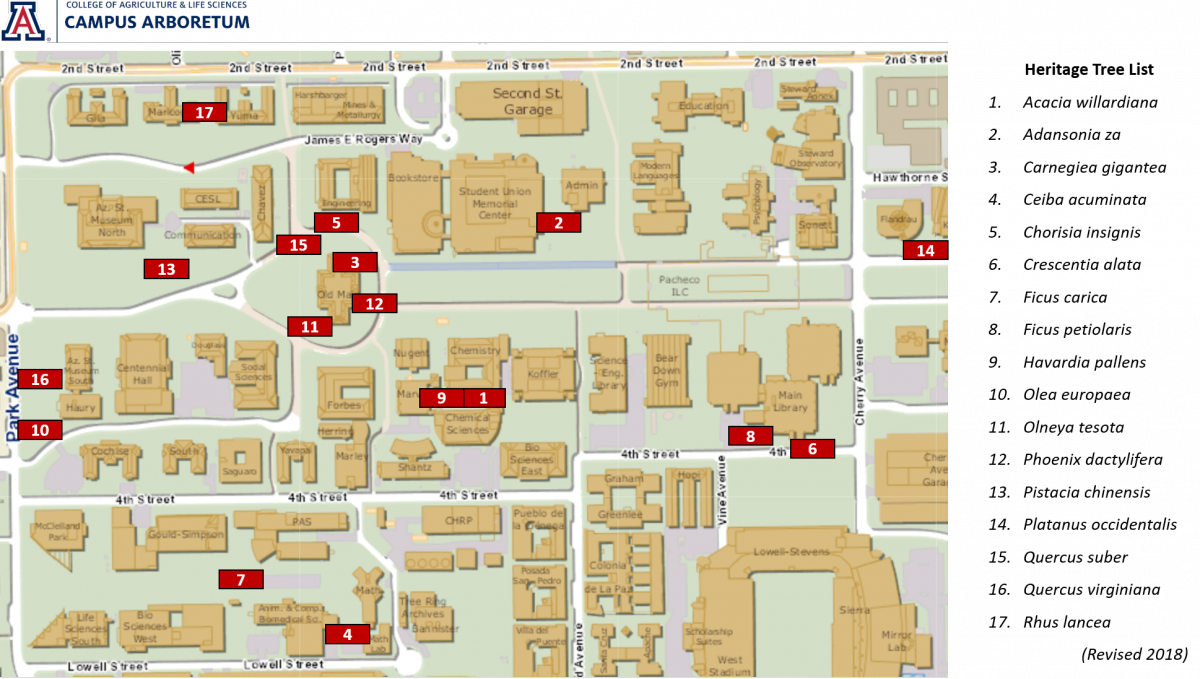
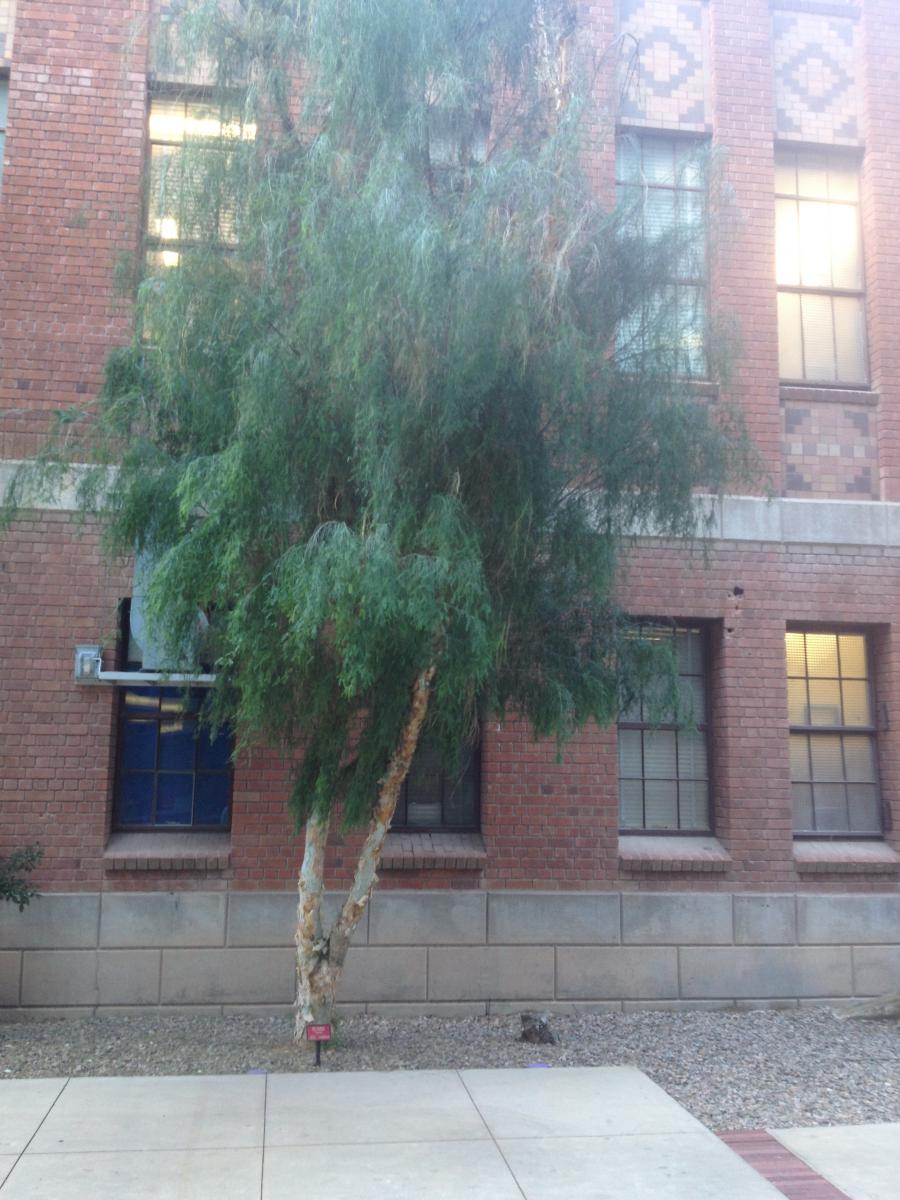
Acacia willardiana
Common Name: Palo Blanco.
Origin: Sonora
Family: Fabaceae
Location:This tree is tucked into "magic alley", a protected walkway south of Old Chem and north of the greenhouses.
Description: The largest specimen of this species on campus, this tree was planted as a seedling by Warren Jones during his career as Professor of Landscape Architecture.
Ethnobotany: (notes) The wood of this tree is used by the Seri Indians of northern Mexico for miscellaneous uses such as hut construction.
References:
Felger RS, Moser MB. People of the desert and sea: ethnobotany of the Seri Indians. Tucson, Arizona: University of Arizona Press; 1985.
NOT AVAILABLE FOR SPONSORSHIP
 Adansonia za
Adansonia za
Common Name: Baobab
Origin: Africa
Family: Bombacaeae
Location: This large tree graces the SW corner of the Administration Building.
Description: It is the only flowering individual tree of its species in the US, according to a botanist at the Missouri Botanical Garden. Seeds brought from Madagascar were germinated in Virginia, and the seedling was subsequently held to 15 gallon size at the Arizona Sonora Desert Museum. It was installed by Warren Jones on campus around 1980. Designated a Great Tree of Arizona, 2002 and sponsored on behalf of the University of Arizona's Campus Arboretum's founding Director, Elizabeth Davison. Although severely damaged by record freezes in 2011, the tree is being carefully managed to restore growth and health.
NOT AVAILABLE FOR SPONSORSHIP
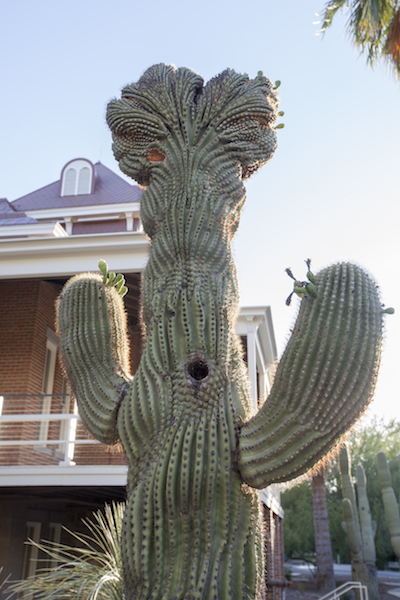 Carnegiea gigantea
Carnegiea gigantea
Common Name: Saguaro
Origin: Deserts of Southwest United States
Family: Cactaceae
Location:This special crested saguaro has stood on the grounds of Old Main for decades.
Description: The cause of cresting is not fully explained, but whatever the stimulus, the growth point of the stem has switched from a geometric point, to a line, which folds and undulates as the crest expands. Cresting occurs naturally throughout the range of the Saguaro, and can be observed in many other cactus species. This iconic campus specimen was removed due to internal rot in 2014. Thanks to the generosity of UA Campus Planning and Facilities Management, and with assistance from arborist Juan Barba and Associates, in locating a new crested specimen, the UA Campus Arboretum has replaced this iconic plant with another beautiful and unique desert wonder. It is worth the effort to view it in person!
Ethnobotany: (notes) Carnegiea gigantea is a member of Family Cactaceae. C. gigantea,or saguaro, is probably the most well know of the Cactaceae family due to its characteristically tall stature with many arms. The Apache Indians of the Southwest used the fruits of C. gigantea as a food source. The fruits can be made into large cakes by extracting the pulp from the fruits, forming the pulp into cakes, and drying it in the sun. The fruits can also be used to produce a juice drink and can be eaten raw. The Pima Indians make a drink from fermented pulp. The juice of the Saguaro cactus was used by the Seri Indians to treat rheumatism.
References:
Buskirk, Winfred 1986 The Western Apache: Living With the Land Before 1950. Norman. University of Oklahoma Press
Dr. Duke's Phytochemical and Ethnobotanical Databases
Hrdlicka, Ales 1908 Physiological and Medical Observations Among the Indians of Southwestern United States and Northern Mexico. SI-BAE Bulletin #34:1-427
Rea, Amadeo M. 1991 Gila River Pima Dietary Reconstruction. Arid Lands Newsletter 31:3-10 (4)
NOT AVAILABLE FOR SPONSORSHIP
 Cassia fistula
Cassia fistula
Common: Golden Shower Tree
Origin: India
Location: W. of Nugent
Family: Fabaceae
Description: The only representative of the species in Tucson. Located. This tree was planted by Warren Jones in the late 1980's. After a few cold damages, it has become large enough to withstand Tucson's winters. In summer, the tree drops its leaves, then produces chains of golden orchid-like flowers from its bare branches.
Ethnobotany: (notes) Cassia fistula a member of the family Caesalpiniaceae is known for its characteristic bunches of beautiful yellow flowers and grows throughout India. The seeds from this tree are used in the treatment of many ailments. Traditionally, the seeds have been found useful in the treatment of skin disorders, swollen throat, biliousness, and jaundice. Presently, there have been investigations into the medicinal use for its anti-oxidant properties. It has been used in traditional Ayurvedic medicine for the treatment of cardiovascular diseases. The seed from the Cassia fistula tree appears to have anti-cancer and anti-bacterial properties in animal models.
References:
Bhakta T. Banerjee S. Mandal SC. Maity TK. Saha BP. Pal M. Hepatoprotective activity of Cassia fistula leaf extract. Phytomedicine. 8(3):220-4, 2001 May
Gupta M. Mazumder UK. Rath N. Mukhopadhyay DK. Antitumor activity of methanolic extract of Cassia fistula L. seed against Ehrlich ascites carcinoma. Journal of Ethnopharmacology. 72(1-2):151-6, 2000 Sep
Luximon-Ramma A. Bahorun T. Soobrattee MA. Aruoma OI. Antioxidant activities of phenolic, proanthocyanidin, and flavonoid components in extracts of Cassia fistula. Journal of Agricultural & Food Chemistry. 50(18):5042-7, 2002 Aug 28
Munasinghe TC. Seneviratne CK. Thabrew MI. Abeysekera AM. Antiradical and antilipoperoxidative effects of some plant extracts used by Sri Lankan traditional medical practitioners for cardioprotection. Phytotherapy Research. 15(6):519-23, 2001 Sep
Perumal Samy R. Ignacimuthu S. Sen A. Screening of 34 Indian medicinal plants for antibacterial properties. Journal of Ethnopharmacology. 62(2):173-82, 1998 Sep
AVAILABLE FOR SPONSORSHIP
 Ceiba acuminata
Ceiba acuminata
Common: Silk Cotton Tree
Origin: South America
Location: SW corner of the Math Building
Family: Bombacaceae
Description: The only individual of its species on campus, this tree is located on the S. With impressive trunk extrusions resembling (but not related to) rose thorns, silk cotton tree is also known for its impressive flowers. These appear in late May, and have long fringe-like stamens. Planted by Warren Jones in 1979, with help from Chuck Raetzman of Facilities Management.
Ethnobotany: (notes) This plant, also know as the kapok tree, is in the Bombacaceae family, blooms at night, and is bat pollinated (by Leptonycteris spp.). The ceiba was a sacred Mayan plant named yaxche with profound symbolic significance, and was revered by priests and used in ceremonies. It is still Guatemala’s national tree. It is related to the more famous kapok species, Ceiba pentandra, whose fiber is used as a stuffing and oil absorbent, and contains isoflavones and glycosides that contribute to a myriad of effects on medical conditions such as high blood pressure, tumors, wounds, and cough. C. pentandra is also one of the admixtures (in addition to Chorisia insignis and Ficus insipida, see below) in ayahuasca preparations used by traditional healers in the healing ceremonies.
References:
Dr. Duke's Phytochemical and Ethnobotanical Databases
Kang,-W.; Jung,-H.S. Excellent oil absorbent kapok (Ceiba pentandra (L.) Gaertn.) fiber: fiber structure, chemical characteristics, and application. J-wood-sci. Bunkyo-ku, Tokyo, Japan : Springer-Verlag Tokyo, [1998-. 2000. v. 46 (5) p. 401-404
Ngounou,-F.N.; Meli,-A.L.; Lontsi,-D.; Sondengam,-B.L.; Atta-Ur-Rahman.; Choudhary,-M.I.; Malik,-S.; Akhtar,-F. New isoflavones from Ceiba pentandra. Phytochemistry-Oxford. Oxford : Elsevier Science Ltd. May 2000. v. 54 (1) p. 107-110
Saleem,-R.; Ahmad,-M.; Ahmed-Hussain,-S.; Mahmood-Qazi,-A.; Iqbal-Ahmad,-S.; Hussain-Qazi,-M.; Ali,-M.; Faizi,-S.; Akhtar,-S.; Nazrul-Husnain,-S. Hypotensive, hypoglycaemic and toxicological studies on the flavonol C-glycoside shamimin from Bombax ceiba. Planta-med. Stuttgart : Georg Thieme Verlag,. May 1999. v. 65 (4) p. 331-334
AVAILABLE FOR SPONSORSHIP
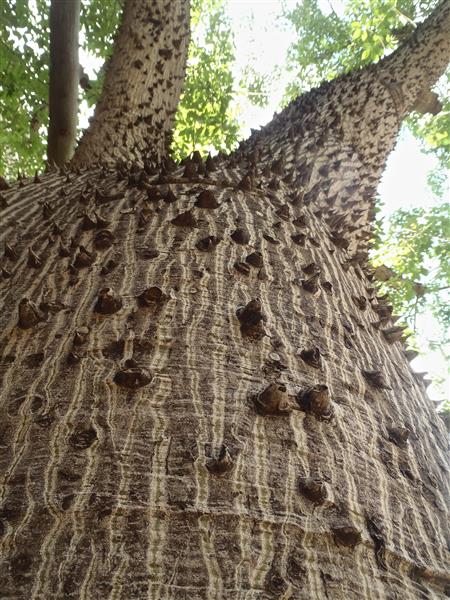 Chorisia insignis
Chorisia insignis
Common: Floss Silk Tree
Origin: South America
Location: South side of Engineering
Family: Bombacaeae
Description: This bizarre old tree is situated on the. Reportedly planted in late 40's-early 50's, it delights students with its creamy orchid-like flowers each winter. (A second individual was transplanted to the S. side of Bio West, from a foothills location in 1984.) Designated a Great Tree of Arizona, 2003.
Ethnobotany: (notes) Trees from the Chorisia genus produce a seed pod that contains a cottony substance which is used in South America as a stuffing for pillows, mattresses and toys. The inner bark of C. insignis is used to make cordage, and the tree itself is hollowed out to make dugout canoes, as per the LA County Arboretum.
References:
The Arboretum of Los Angeles County Plant Information ( www.arboretum.org/arboretum/articles/winter1999/apaths.shtml)
AVAILABLE FOR SPONSORSHIP
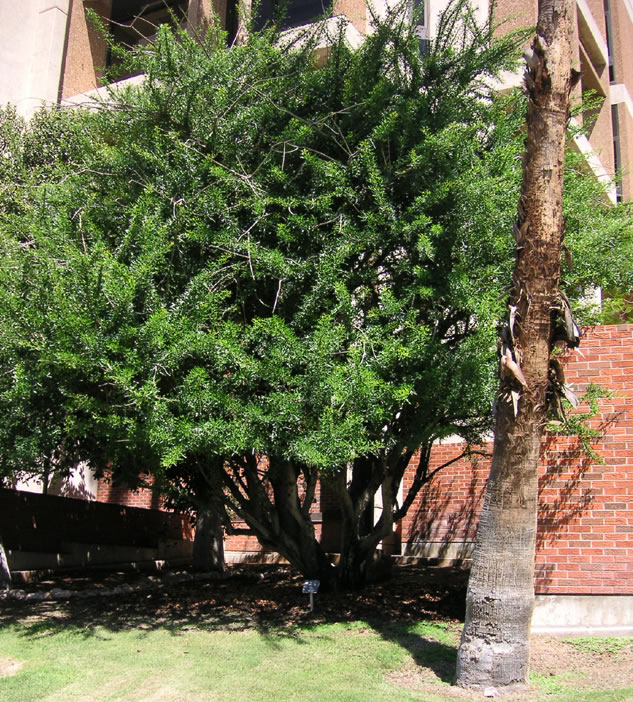 Crescentia alata
Crescentia alata
Common: Calabash Tree
Origin: Central America
Location: SE side of the Main Library
Family: Bignoniaceae
Description: One of only three on campus, and by far the largest. No others known in Tucson. This tree is unique for its bat pollinated flowers and fruits that develop on the trunk. Seed collected on western coast of Mexico, and small tree planted by Warren Jones, in 1970's, as an experiment. Designated a Great Tree of Arizona, spring 2002.
Ethnobotany: (notes) Crescentia alata has been used in Mexican and Guatemalan traditional medicine for respiratory infections and as an anti-inflammatory, respectively. The anti-inflammatory characteristics have been demonstrated in animal models, and the anti-microbial characteristics have been observed against Staphylococcus aureus, Enterococcus faecalis, Streptococcus pneumoniae, Streptococcus pyogenes, Escherichia coli, and Candida albicans. Crescentia alata fruits, also known as morro or jicara, are used to produce a vegetable milk in Guatemala.
References:
Autore G. Rastrelli L. Lauro MR. Marzocco S. Sorrentino R. Sorrentino U. Pinto A. Aquino R. Inhibition of nitric oxide synthase expression by a methanolic extract of C.alata and its derived flavonols. Life Sciences. 70(5):523-34, 2001 Dec 21
Figueroa Madrid SA. Bressani R. [Vegetable food resources with agroindustrial potential from Guatemala. Manufacture of vegetable milk from the seed of morro fruit (Crescentia alata)]. [Spanish] Archivos Latinoamericanos de Nutricion. 50(2):164-70, 2000 Jun
Rojas G. Levaro J. Tortoriello J. Navarro V. Antimicrobial evaluation of certain plants used in Mexican traditional medicine for the treatment of respiratory diseases. Journal of Ethnopharmacology. 74(1):97-101, 2001 Jan
AVAILABLE FOR SPONSORSHIP
 Ficus carica
Ficus carica
Common: Edible Fig.
Origin: Mediterranean
Location: East of Gould Simpson
Family: Moraceae
Description: A specimen that, in the 1930s, was on the site of a private home on 5th street where the Franklin Building now stands. In 1959, it was preserved during the construction of the Franklin Building, and stood in the south entrance for 30 more years. In 1989 it was saved, through public support, when Gould Simpson building was erected, and transplanted to its current site by Chuck Raetzman's crew.
Ethnobotany: (notes) In addition to the delightful edible fruits, Ficus carica leaf extracts are used to lower glucose levels in diabetics, and lower the levels of total cholesterol, triglycerides, and the total cholesterol/HDL cholesterol ratio. These effects seem to stem from several of the compounds found in the plant’s latex. In addition, Ficus carica has been used to treat many other medical conditions, such as cough, flu, asthma, cancer, abscesses, constipation, and gingivitis.
References:
Dr. Duke's Phytochemical and Ethnobotanical Databases
McGovern TW. The fig--Ficus carica L. [Review] [9 refs] Cutis. 69(5):339-40, 2002 May
Rubnov S. Kashman Y. Rabinowitz R. Schlesinger M. Mechoulam R. Suppressors of cancer cell proliferation from fig (Ficus carica) resin: isolation and structure elucidation. Journal of Natural Products. 64(7):993-6, 2001 Jul
Canal JR. Torres MD. Romero A. Perez C. A chloroform extract obtained from a decoction of Ficus carica leaves improves the cholesterolaemic status of rats with streptozotocin-induced diabetes. Acta Physiologica Hungarica. 87(1):71-6, 2000
Perez C. Canal JR. Campillo JE. Romero A. Torres MD. Hypotriglyceridaemic activity of Ficus carica leaves in experimental hypertriglyceridaemic rats. Phytotherapy Research. 13(3):188-91, 1999 May.
AVAILABLE FOR SPONSORSHIP
Ficus petiolaris
Common: Rock Fig
fOrigin: Baja California
Location: SW side of the Main Library
Family: Moraceae
Description: The only one of its species on campus, and the biggest in Tucson. Seed (or seedling) collected in Mexico, cultured at UA Campus Ag Center. Planted in early 1980s by Warren Jones.
Ethnobotany: (notes) This plant, in Family Moraceae, has numerous medicinal uses, such as for fever, ulcers, wounds, and fractures.
References:
Dr. Duke's Phytochemical and Ethnobotanical Databases
NOT AVAILABLE FOR SPONSORSHIP
_______________________________________________________________________________________________________________________________________________
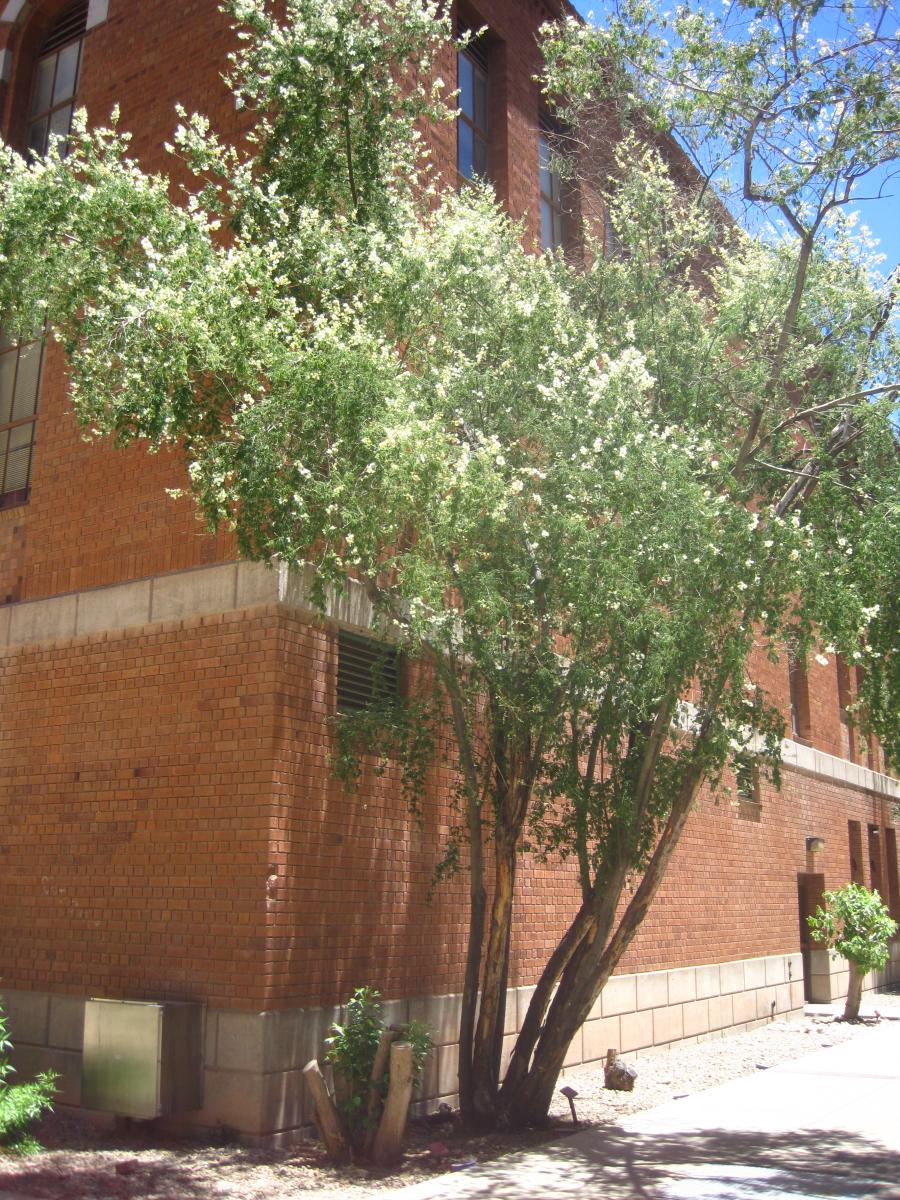 Havardia pallens
Havardia pallens
Common: Tenaza
Origin: Mexico
Location: Magic alley – South of Old Chemistry
Family: Fabaceae
Description: This tree is the largest of its species on campus. A Sonoran native, it is the biggest in Tucson, and quite possibly in the state of Arizona. Planted by Warren Jones during the 1970's, it has thrived in the warm microclimate next to the Chemistry building.
Ethnobotany: (notes) A tree native to Mexico commonly called tenaza or huajillo, H. pallens is in the bean family, Fabaceae.
NOT AVAILABLE FOR SPONSORSHIP
Olea europaea
Common: Olive
Origin: Middle East
Location: Park Ave. Green Belt
Family: Oleaceae
Description: All the olive trees on the western part of campus are included as heritage trees. Any olive tree that has a special meaning for the donor may be adopted. The oldest ones are on the N. side of North Campus Drive. Planted by Robert Forbes in the late 1800's, the trees were part of a variety trial for Forbes's investigation of agricultural crops from dry lands around the world, with potential for use in Tucson. In the early years of the 20th century, olives were planted along all walks in the Historic District on the west of campus.
Ethnobotany: (notes) Olives, and olive oil are well known for their culinary uses and related health benefits as a monounsaturated fatty acid. There are also a range of documented uses for hair, cancer, fever, and high blood pressure. In addition to these benefits, the inhalation of Olea europaea pollen is one of the most important causes of allergic respiratory diseases in the Mediterranean basin.
References:
Carnes Sanchez J. Iraola VM. Sastre J. Florido F. Boluda L. Fernandez-Caldas E. Allergenicity and immunochemical characterization of six varieties of Olea europaea. Allergy. 57(4):313-8, 2002 Apr
Dr. Duke's Phytochemical and Ethnobotanical Databases
MULTIPLE AVAILABLE FOR SPONSORSHIP
Olneya tesota
Common: Ironwood
Origin: Desert Southwest
Location: SW of Old Main
Family: Fabaceae
Description: This slow growing desert species was planted as part of the Campus Arboretum dedication ceremony, in September 2002. The event marked the culmination of the four previous years' efforts toward establishing an arboretum and joining the American Association of Botanical Gardens and Arboreta. It is destined to become a long lived representative of the University's origins as the Land Grant Institution in the Sonoran Desert of the Arizona Territory.
NOT AVAILABLE FOR SPONSORSHIP
____________________________________________________________________________________________________________________________________________________
Phoenix dactylifera
Common: True date palm
Origin: Middle East
Location: East of Old Main
Family: Arecaeae
Description: This tree was given to the University in 1955 by students from Iraq. It honors Dr. Phillip Eckert, Dean of the UA College of Agriculture. At that time the University was collaborating (with the US Dept. of State and the US Dept. of Agriculture) to assist in the development of the Agricultural College of Iraq at Abu Ghraib, near Baghdad. This was one of the first such collaborations between a US university and a foreign government. Dr. Phillip Eckert was Dean of the College of Agriculture in 1952. He had responsibility for coordinating the project. To honor and thank him in 1955, Iraqi students planted a date palm from Iraq on campus. The tree still stands by Old Main. Recently his daughters, Susan Eckert and Karen Sanzone visited campus with Patricia and Hussam Urfali, (wife and son of of Hufdhi Urfali, one of the original Iraqi students). The 50 year old tree has an interpretive sign to honor Dr. Eckert and his efforts in establishing the Agricultural College of Iraq.
Ethnobotany: The yellow orange to red dates are oblong and about 1.5 inches in length. These are harvested in late summer and early autumn. Ripe dates are rich in sugar, 60-80% of the contents. Ethnobotany: The word “date” comes from an Ancient Greek word “dáktulos”, meaning finger. The tree is cited 10 places in the Quran. Generally grown in arid regions with supplemental water, a single palm can produce in excess of 250 pounds of dates per season. Health Benefits: Dates contain tannins with antioxidants properties that are proven to have anti-inflammatory characteristics. Dates are also a great source of Vitamin A which helps with vision, and skin health, and protects from oral and lung cancer. Dates protect against age-related macular degeneration as a result of the high level of the carotenoid zea-xanthin.
References:
Phoenix dactylifera, Date Palm. University of Florida Extension Publication #FOR 252 by Melissa H. Friedman, Michael G. Andreu, Heather V. Quintana, and Mary McKenzie
AVAILABLE FOR SPONSORSHIP
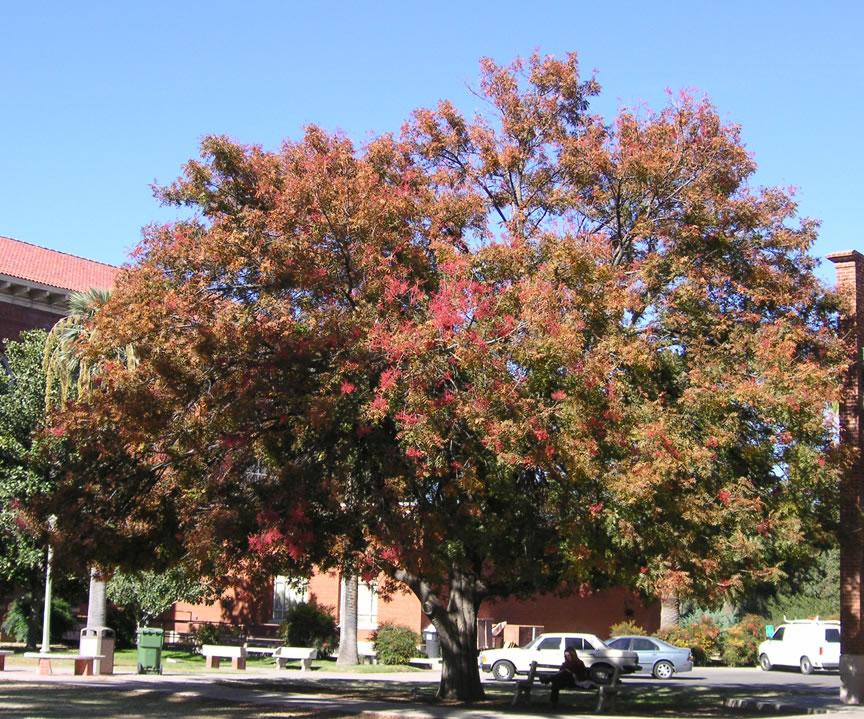 Pistacia chinensis
Pistacia chinensis
Common: Chinese Pistache
Origin: Asia
Location: SW of Communications
Family: Anacardiaceae
Description: The largest and most vigorous of its species on campus. Located S, this elegant tree glows each autumn with copper leaves and red fruit. It has been a fixture in the Historic District of campus since the late 1960's. Designated a Great Tree of Arizona, 2004.
Ethnobotany: (notes) Twigs of Pistacia chinensis, a tree in the Family Anacardiaceae which includes plants such as cashews, mangos, and poison ivy, were found to have two novel ingredients with estrogen-like activity.
References:
Nishimura S., Taki M., Takaishi S., Iijima Y., Akiyama T., Structures of 4-aryl-coumarin (neoflavone) dimmers isolated from Pistacia chinensis UNGE and their estrogen like activity. Chemical and Pharmaceutical Bulletin. 48(4): 505-8, 2000 April
NOT AVAILABLE FOR SPONSORSHIP
Platanus occidentalis
Common: American Sycamore
Origin: Eastern US
Location: E of the Kuiper Sciences building
Family: Platanaceae
Description: Called the "Moon Tree" Sycamore as it was grown from seed that went to the moon with the Apollo 14 mission in 1971. The tree's value and unique history is explained on a plaque installed by the Arizona State Forester in 1976. See more about the Moon Trees at http://nssdc.gsfc.nasa.gov/planetary/lunar/moon_tree.html
Ethnobotany: (notes) This monoecious plant has been used as a tonic and fever treatment. This tree is a member of the Platanaceae, or sycamore, family, which includes many economically important uses such as wood products and landscape ornamental trees.
References:
Dr. Duke's Phytochemical and Ethnobotanical Databases
AVAILABLE FOR SPONSORSHIP
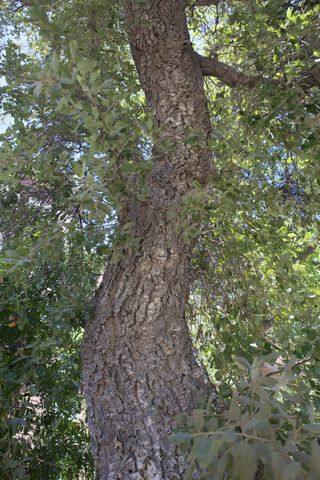
Quercus suber
Common: Cork Oak
Origin: Mediterranean
Location: South side of the Engineering Building
Family: Fagaceae
Description: This specimen is the largest of its species on campus. Planted some time prior to 1940, Steve Fazio, former Professor of Plant Sciences, remembers showing his young children the tree in the late 1940’s. Alumni who were on campus in the 1960s remember using it as part of a fraternity initiation ceremony. Today students of botany, landscape architecture, ecology, and other sciences learn about the centuries-old technique of sustainably harvesting cork by peeling off the bark. Designated a Great Tree of Arizona in 2004.
Ethnobotany: (notes)
NOT AVAILABLE FOR SPONSORSHIP
Quercus virginiana
Common: Southern Live Oak
Origin: Southeastern USA
Location: South end of the Park Ave. Green Belt
Family: Fagaceae
Description: This dark-leafed, spreading tree was planted by former Professor of Horticulture Steve Fazio around 1950. Steve tells how he planted several acorns in the Park Ave. Green Belt area, and this one remains. Undoubtedly, it is the largest southern live oak in Tucson. Designated a Great Tree of Arizona, spring 2002.
Ethnobotany: (notes) This tree, in the Fagaceae, or beech and oak family, has traditional medical uses for dysentery, eye disorders and sores.
References:
Dr. Duke's Phytochemical and Ethnobotanical Databases
AVAILABLE FOR SPONSORSHIP
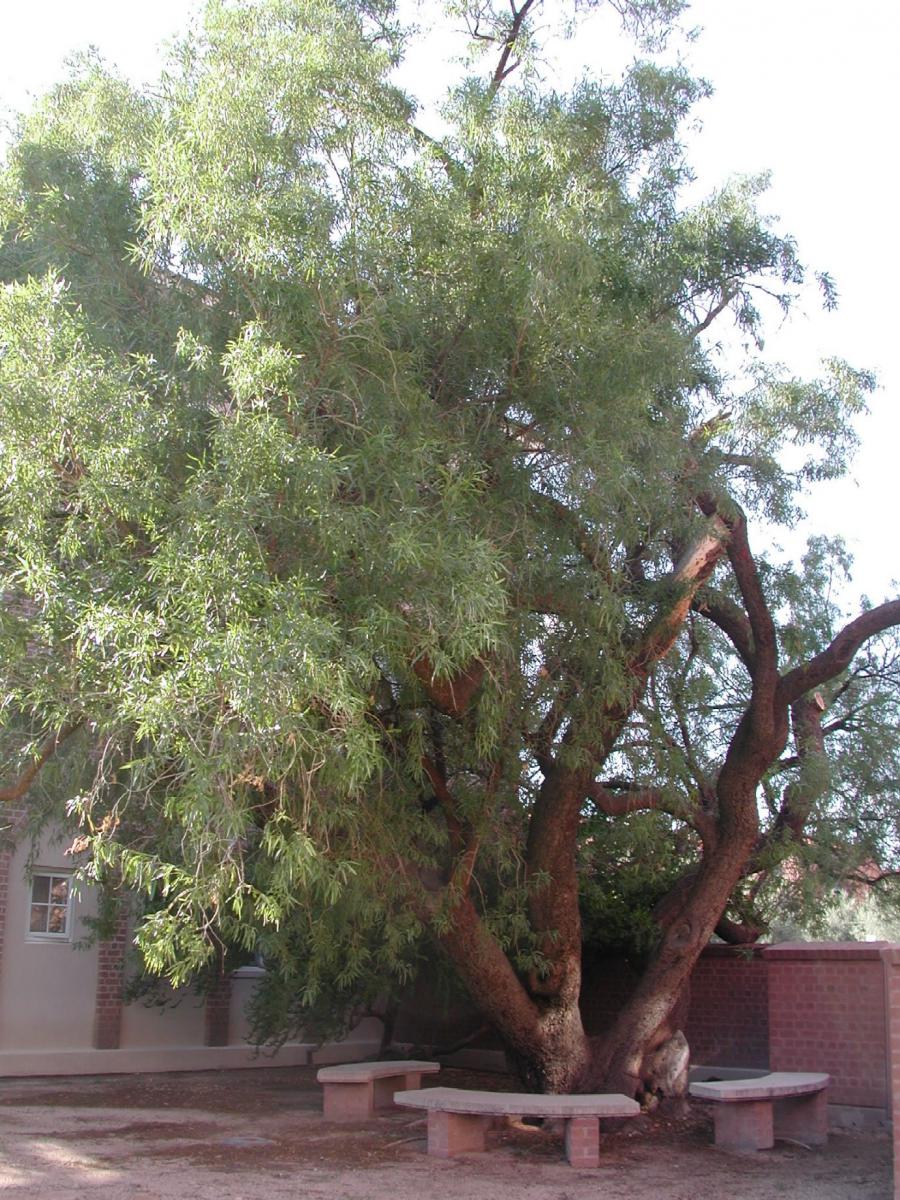 Rhus lancea
Rhus lancea
Common: African Sumac
Origin: Africa
Location: Between Maricopa and Yuma Hall
Family: Anacardiaceae
Description: The large stately tree between Maricopa and Yuma Hall was the first one planted in Tucson. The seeds were collected in North Pretoria, South Africa in 1919 by former President Homer Shantz. After germination in Chico, CA, two seedlings were transported to Arizona: one taken to Boyce Thompson SW Arboretum in Superior, AZ, and the other eventually planted on the UA campus in 1928. Designated a Great Tree of Arizona in 2003.
AVAILABLE FOR SPONSORSHIP



